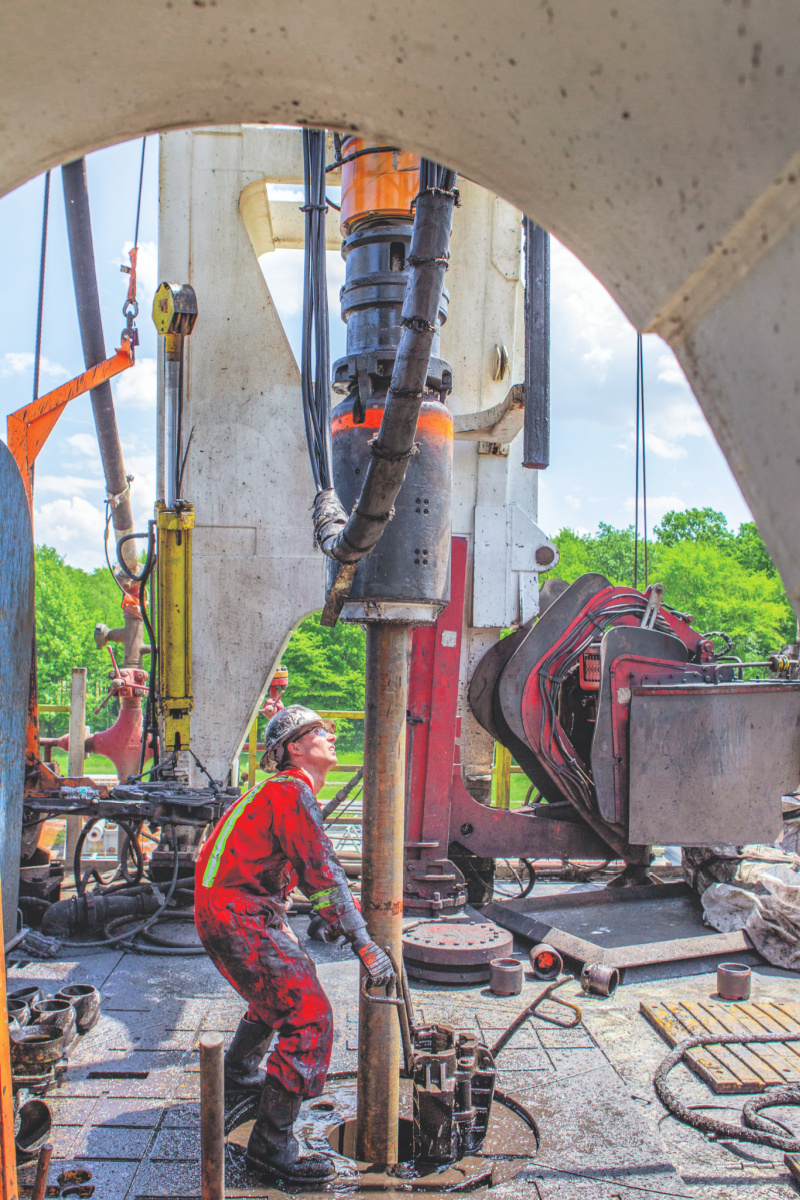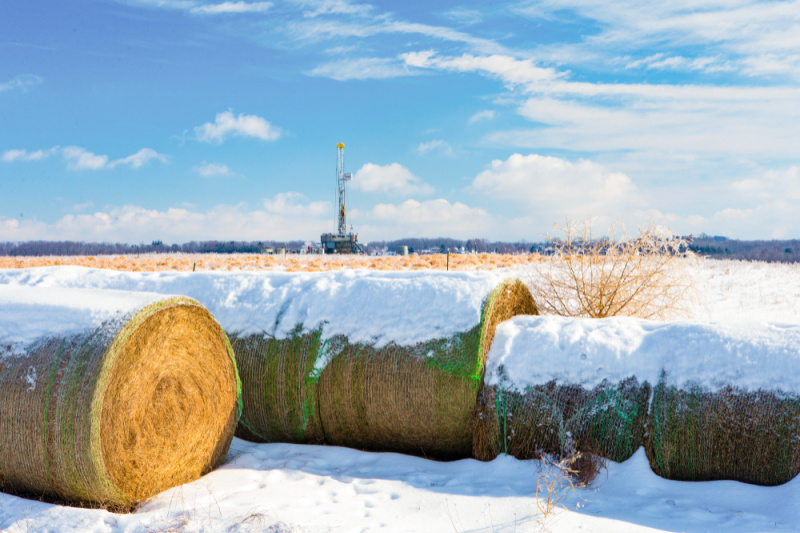Presented by:
[Editor's note: A version of this story appears in the June 2021 issue of Oil and Gas Investor magazine. Subscribe to the magazine here.]
The Appalachian Basin may be one of the most cutthroat shale plays in the world, grappling with global competition, pipeline constraints and a consistently disappointing commodity price.
Paradoxically, operators within the basin cannot seem to contain themselves. Even after a season of pandemic sapped demand, production in the Marcellus and Utica shales was seemingly in a world of its own.
While 2020’s natural gas prices cut about 1% of U.S. natural gas production, the Marcellus and Utica shale states of Ohio, West Virginia and Pennsylvania produced 33.6 billion cubic feet per day (Bcf/d) in 2020, a 5% increase year-over-year.
Texas produced the most natural gas in 2020 among all of the states, but volumes decreased to 28.1 Bcf/d in 2020 from 28.4 Bcf/d the previous year, according to the U.S. Energy Information Administration, which bases its figures on gas supply withdrawals.
After outperforming the XOP by 39% in 2020, companies in the Appalachian Basin have seen a reversal, with oily names increasing by 27% in value through late April, said Cowen analyst David Deckelbaum.
The natural gas curve is now “off 10% since the highs of February, and East Coast basis has widened to 24%” below Henry Hub, Deckelbaum said in an April report.
Appalachia’s song may seem somewhat familiar—a save-time-in-a-bottle melody. E&Ps are forced to keep gas in storage because of differential costs. Several major E&Ps are maintaining maintenance-level capex budgets this year. And rig activity is expected to change, perhaps by one or two rigs, according to Goldman Sachs.
Companies such as Antero Resources Corp. and privately owned Northeast Natural Energy LLC are both prepping for an immutable natural gas price.
“We expect to be in maintenance mode here going forward,” said Daniel Katzenberg, Antero Resources’ director of finance. “The growth era for Antero is complete.”
Mike John, CEO of Northeast Natural Energy, has also cast out any magical thinking regarding commodity prices.
“I guess I’ve given up on thinking that we just need a price spike to bail us out,” he told Oil and Gas Investor. “That was a key lesson for me and hopefully a key lesson for a lot of other folks. Because if you’re not willing to put aside that aspiration, then I think you’re subject to disaster.”
If basin operators are resigned to a slower pace of activity, they are eager to capitalize on several inherent advantages. Operators are technologically advanced. Their teams have weathered multiple severe downturns and learned the rock beneath them.

Many operators say they are poised to generate hefty free cash flow even in a tough market. Many of the basin’s operators also have an advantage over oil companies because of their early adoption of sustainability goals, such as reduced methane emissions.
The Marcellus Shale also suits the oil and gas industry’s transition to Shale 3.0, a still nebulous phase in which E&Ps will attempt to deliver consistent shareholder returns via cash flow generation while balancing capex and environmental stewardship.
Tug Hill Operating COO Sean Willis said the Appalachian company has demonstrated that environmental stewardship and economic prosperity are not mutually exclusive decisions or outcomes.
“You’re not compromising one for the other,” he said. “We feel like we’ve made the right environmental decisions that, as a result, are also the right economic decisions.”
As for repeatable cash flow, Antero Resources’ Katzenberg sees the Marcellus’ rock having enough uniformity, thanks to low natural fracturing, to support manufacturing-style repeatability. The shale also compares well against other gas producing basins, including those in Texas and Louisiana, Katzenberg said.
“That allows for all of your wells to be very consistent,” he said. “You don’t see that in other basins. If you look at other shale basins in the U.S., whether it’s the Permian [Basin] or another natural gas basin like the Haynesville [Shale] you end up having natural faults that can cause disruptions in your drilling results and not allow for long lateral drilling. Repeatable drilling results deliver predictable operating performance.”
Appalachia may be the basin to beat, not for production, but as companies turn back high-debt ratios and begin to throw off cash flow.
First blush
Perhaps the most important task Antero Resources had lined up in 2021 has already been accomplished. In the first quarter, the company reduced its debt by $433 million and expects its net debt to EBITDA to fall below 2x this year.
While Antero Resources’ first-quarter production was 1% lower than expected, the company “still managed to crush Street EBITDA estimates by about 19% on the heels of higher NGL and natural gas realizations,” Raymond James analyst John Freeman observed in an April report.

Antero expects to generate $600 million in free cash flow this year, which Freeman called “conservative at first blush”—considering its first-quarter haul of $416 million. And by 2025, the company intends to be on the path to producing $2 billion in free cash flow.

Antero Resources puts the Marcellus Shale, and its assets, in an elite class among the resource basins of the world. Its footprint has thousands of locations, complimentary midstream assets and a built-in customer base that includes population centers in the Northeast, including New York City, Philadelphia and Boston.
Surviving to this point, and now pulling ahead in 2021, has required Marcellus operators to change their mindset—with their hands forced by supply gluts and sputtering demand.
In 2018, Antero Resources drilled and completed (D&C) 164 wells at a cost of about $1.5 billion. In each year that has followed, the company has spent fewer dollars on its drilling campaign. As of May, its 2021 D&C budget is an estimated $590 million—about 60% less than three years ago.
The company now claims a spot as the second largest NGL producer and third-largest natural gas producer in the U.S.
Among Appalachia operators, Antero Resources is the largest U.S. NGL exporter with the most international exposure through Mont Bellevue. The company’s propane position continues to be a leading source of cash flow.
“Looking back at 2020, you saw a great example of how inelastic global propane demand is. As transportation fuels, specifically oil, saw significant demand destruction, there was little impact on demand for propane.” Katzenberg said. “And that’s because you see that baseline support from demand in China and India, which is significant.”
With leasehold of about 451,000 net acres in West Virginia, the company is distinct from many of its peers in Pennsylvania. Antero Resources also holds about 91,000 net acres in eastern Ohio.
In West Virginia, Antero Resources has amassed a large, contiguous acreage position with current operations centered in Tyler and Wetzel counties, where the rock allows for drilling pads to operate side-by-side.
“The efficiencies that you get from being able to drill repeatable wells and pads right next to each other, while not having to do these large step outs, really helps drive down your well cost and leads to more efficient drilling.”
The company has fine-tuned its drilling through multiple industry slumps, improving drilling and completion plans that have led to lower costs. This year, Antero Resources also reported a U.S. record for lateral drilling, crossing 12,118 ft in 24 hours.

This year, Antero Resources is completing more than nine stages per day compared to about eight per day last year.
“We continue to improve on our drilling metrics. In combination, all these improvements help accelerate the time that it takes to drill the well and ultimately reduces the well cost.”

That improvement has helped drive down capex, which leads to free cash flow on a sustained basis, he said.
Marcellus operators are now beginning to hear questions about the region’s service sector, where the deflationary environment surrounding prices is beginning to abate.
Katzenberg said Antero Resources has not itself seen cost inflation yet. The company is locked in at three gross rigs, even accounting for its recent joint venture with Quantum Energy Partners, which netted Antero Resources $500 million to $550 million in proceeds.
“We expect our operated rig count level to stay flat,” he said. Our maintenance plan is about 65 net wells (drilled).”
Should prices increase, Antero is confident in its own efforts to cut costs and improve operational efficiency, which it pegs at 80% of the recent capex savings. Service companies will eventually have to boost their margins, but with few new rigs expected in the Marcellus Shale, inflation still appears to be a longer-term concern.
“We do not see rig rates climbing meaningfully in the Northeast, and we have a similar outlook on the completion side,” he said. “So at least in the Northeast, we don’t think that inflation will be a significant factor in 2021 and should be pretty minimal in 2022.”
On the private side, however, some companies have different plans.
Three rig hill
Heading into 2020, Tug Hill Operating’s management had bold growth plans for its Utica Shale/Point Pleasant stacked pay.
Initially, Fort Worth, Texas-based private independent, planned to run five rigs on its leasehold, drilling 3,000 ft deeper than the Marcellus Shale to reach the Utica Shale. Since 2018, the company had been actively co-developing their leasehold and while driving a leaner operation.
The pandemic hit and Tug Hill Operating was forced to drop down to three rigs.
“While most operators are executing maintenance capex programs, whereby keeping their production relatively flat to enable their ability to generate free cash flow, we are able to grow our business at more than 20% CAGR while also generating high levels of free cash flow,” Willis said.
Though Tug Hill Operating is private, the team benchmarks their performance each day and strives for continuous improvement. As such, Tug Hill sees itself as a best-in-class operator among its Appalachian peers, and it is proud of the reputation it has established within the communities.
“Every decision we make is underpinned by our commitment to environmental stewardship, deep technical analysis and economic returns,” Willis said. “By focusing on becoming more efficient as our organization has grown, we have generated basin-leading margins that drive our economic returns. And because of that, we’re able to develop our resources more effectively, which is what drives our investment decision to grow our volumes and continue to build the company for longterm value creation.”
Tug Hill Operating expects to spend about $300 million on capex on its drilling program this year and turn in line more than 40 well.


“Relative to 2020, where we turned in line 30 wells for the year, in 2021 we’re planning to bring on nearly 50% more wells and continue to grow volumes throughout the course of the year.”
Like most operators in the Appalachia Basin, Willis sees the basin as superior to the Barnett or Haynesville shales. While West Virginia has many unique challenges for Tug Hill Operating, tapping into the Utica Shale was also a multiyear long process of refinement.
“We have unlocked a vast resource in the Utica,” he said.
The ability to economically drill in the Utica Shale/Point Pleasant took time, skill and science.
“We’ve learned a ton about the Utica, the rock, the reservoir, and not only the resource in place and how to produce it, but how to drill there economically,” he said. “We were very methodical, data-driven, and we have brought fit-for-purpose practices.”
Early on the Utica Shale was considered a promising play with a lot of unknowns. While many company’s early appraisal efforts of the Utica Shale/Point Pleasant across West Virginia and western Pennsylvania came at a very high price, with well costs frequently exceeding $30 million, the reservoir demonstrated strong production performance. In 2018, Tug Hill Operating’s first Utica Shale/Point Pleasant well served as a platform to collect the necessary data that was required to provide the level of conviction necessary to move into full scale development. The company took a pressure core that allowed it to directly measure the rock properties and really understand how best to develop to reservoir.
“We have direct measurements of the gas in place, which tells us a lot of things that you can’t get without years and years of production data from wells. It also gave us data on where we land our wells, why we frac them the way we do. It supplied us with a whole spectrum of data that has been a key factor in our ability to unlock the potential of this world-class resource.”
Tug Hill Operating has now developed about 40 Utica wells and proven the prolific play underlying the Marcellus.
“It is a game changer for the asset and the acreage,” he said.
The Utica Shale/Point Pleasant also affords Tug Hill Operating optionality between dry gas and liquids-rich development across the same asset footprint that allows the company to shift the development focus as commodity prices change.
“I know some of our peers talk about combo development, whereby developing adjacent units in a common reservoir in a systematic manner to gain development efficiencies and overall capital efficiencies,” Willis said. “We do that too, but we also do it in three dimensions. We have a whole different reservoir down below that we’re codeveloping from common pads.”
Tug Hill Operating plans call for pads that can accommodate up to 30 wells. The company currently operates 20 well pads that have led to successful development and the efficient use of space that it has to work with, Willis said.

The company is set on making the right decisions for itself and the environment ensuring it’s stewarding the capital of their investors in a responsible manner.
“I think that we have a responsibility, especially as it relates to some of the ESG, because the industry has a long way to go. But we want to be part of that journey and sharing lessons as well.”
Marcellus marvel
The ongoing marvel of the Marcellus Shale is not so the abundance of gas but that there seems to be no stopping it.
But the economics of the Appalachian Basin require the strictest attention to every part of an operation. Everything from acquisition costs to artificial lift must be scrutinized to ensure success. What’s clear to operators such as Northeast Natural Energy, which has been explored for more than 150 years, is no country for fantasists.
John, the company’s CEO, said the talent and ingenuity of the people in the Marcellus Shale has led the way in lowering the costs associated with producing natural gas so that the company can continue to make a profit.
“There’s no shortage of natural gas in our part of the country. Cost control is what we’ve focused on and will continue to focus on. I call it margin. We’ve got to keep our cost structure extremely low. We’re drilling wells for $600 a foot, all in—drilled and completed. And, our lifting cost is less than a quarter.”
“It was all about shale,” John said, while reminiscing about the path that brought him to start Northeast Natural Energy. In 2009, coming off a stint as vice president for operations at Chesapeake Energy Corp., it was clear from his private equity connections that the time was right to create another private exploration company. He had a successful track record, as the company he helped form was purchased by Chesapeake Energy in 2005.
“In 2009, we put together Northeast Natural Energy with the clear vision that we would easily be able to turn and sell the company in three or four years,” he said, adding in a deadpan voice, “So here we are in 2021 having not done that yet.”
What Northeast Natural Energy did instead is build a focused area footprint that efficiently taps natural gas in the Marcellus Shale.
“One of the things I’m really fond of saying about the company and the work we do in northern West Virginia, is ‘we’re from here, and this is where we’ve always been.’”
Northeast Natural Energy’s brand recognition is based on being a group of people who are successful doing what they love. “We’re really lucky. We get to do what we want to do [and] where we want to do it,” he said.
The company has continued to drill horizontal, dry gas Marcellus Shale wells, primarily in Monongalia County, W.Va. Northeast Natural Energy has 103 wells online, producing 400 million cubic feet per day (MMcf/d) of natural gas. The company has about 50 employees and a relatively compact acreage footprint.
Asked about the recent large mergers in the Permian Basin, John said scale is fine. But Northeast Natural Energy is more focused on its margins.
In particular, the company focuses on efficiently deploying capital and the timelines required to acquire land rights. Buttoning up large undeveloped land positions in large transactions has been impractical, John said. It’s takes special focus and “mental understanding” that the tract sizes are small, the mineral interests are fragmented and the ownership records are complex.
“It takes a lot of time and research to put together the land that you need to develop long length laterals that are drilled today,” he said. “We’re comfortable drilling 15,000- to 18,000- foot laterals—five or six in each direction from a pad. So there’s a lot of land that has to be accumulated.”
But the Marcellus Shale geology has made longer-reach wells essential for operators to maximize profits. John described Northeast Natural Energy as a one-rig shop that will drill 20 to 25 wells a year—a drilling program not dramatically different than some other major operators in the Appalachian Basin.
“You can’t drill 3,000-foot horizontal wells and expect to make money,” John said. “You’ve got to drill longer wells, and you’ve got to be very efficient with your water. You’ve got to be efficient with your sand handling, all those things.”
As for the future of the Marcellus Shale, John looks to the past. For the first 20 years of his career, the Appalachian Basin produced 15 Bcf/d or less. Today, even with COVID-19 and enhanced capital discipline, the basin is still churning out 32 Bcf/d.
With the underperformance in the sector during the past few years, there’s been a noticeable slowdown in the deployment of capital toward D&C wells in the Northeast, he said.
“Over the course of my career, there has been a tremendous upheaval in the way natural gas pricing in Appalachia works,” he said. “For many years, our gas sold for a 25 cent to 50 cent premium to Henry Hub. And now with the world class reserves in Appalachia we need to sell our gas at a 60 cents to 70 cents discount to Henry Hub—some months the discount is as much as a buck.”
But capital discipline from large companies like EQT Corp., Cabot Oil & Gas Corp. and CNX Resources Corp. should make a difference in controlling the locational price differential, even as Northeast looks to grow.
“But Northeast Natural Energy is a small company. If our production grows from 400 million a day to 500 million a day, that should not move the needle regarding locational price differential,” he said.
A lingering sustain
A significant advantage for Appalachian Basin operators has been their first-mover status as proponents of natural gas emissions protocols. Though not limited to one basin, such companies are already finding themselves graded above the curve compared to their oilier peers.

Christopher Nielsen, Antero Resources’ director of sustainability, told Oil and Gas Investor he continues to see pressure on producers to reduce their methane and greenhouse gas (GHG) emissions.
“At the same time, many Northeast gas companies have been leading the way on reducing their emissions while establishing industry leading emissions performance,” he said, adding that recent ESG scorecards by Credit Suisse and Wells Fargo have ranked Appalachian gas-weighted producers “much better on environmental metrics than their oily peers.” Antero Resources was an early member of One Future, a consortium of operators focused on science-based methods of reducing methane emissions to 1% or less of total natural gas production. Tug Hill Operating and Northeast Natural Energy are also members.
“We’re a couple years into our sustainability journey and are well-positioned to take the next step,” Nielsen said. “We feel that we have a great ESG story to tell and the leadership and proven performance to back it up.”
Antero Resources has taken the initiative to develop 2025 goals that further reduce their already low GHG intensity by 10%, lowers its methane leak loss rate by 50% to under 0.025% and to achieve net zero Scope 1 carbon emissions through the implementation of operational improvements, technologies and the purchase of carbon offsets.
“Our position in low CO₂ intensity basins, combined with our commitment to achieve industry leading environmental performance, will allow Antero to continue providing low-cost, low-emitting energy to our customers in both domestic and international markets,” Katzenberg said.
Natural gas companies have had a tough slog the past several years as prices have remained stagnant, but Antero Resources is confident in the demand picture it sees in the next two decades.
“If you look at IEA estimates and other third-party projections, you see that natural gas demand is expected to be stable under the base case through 2040 or increasing slightly as it takes market share through 2040,” Katzenberg said. “You have coal and oil starting to see some decline in demand. But natural gas is expected to remain consistent.”
Willis said the push toward a lower carbon future—including increased regulation and the perception of fossil fuels by a large cross section of society—will lead to more carbon-intense forms of energy being phased out. Any company that does not continuously adapt to ESG issues and demonstrate through performance, their commitment to methane emissions reduction will not have access to capital and it will compromise their license to operate.
“Our view is that natural gas will continue to play a significant role to a lower carbon future and that natural gas should be the fuel of choice given its abundant supply, reliability, affordability and emissions profile of it relative to other sources,” he said.

“When you look at natural as demand, LNG is something that everyone continues to watch, and it is something that I feel we will be a key driver for the continued demand growth for our products we produce. That’s what you see with the LNG demand, that there is a need for it. And I think we’ll continue to see that as a growing global demand [source],” he said.
As an industry, we have an obligation to do a better job of explaining natural gas’ role in the energy transition to a lower carbon future. “My view is that we have to build companies for the long term that work to ensure a responsible transition to net-zero emissions.” he said.
In first-quarter 2021, Tug Hill Operating initiated a pilot project with Project Canary to bring transparency and verifiable date to complement their ongoing methane mitigation efforts. The company said it wants to lead by example in its environmental stewardship efforts. That includes taking part in a pilot project on four pads for Project Canary’s TrustWell, which will give the company a responsibly sourced gas (RSG) certification.
Too many people, he said, tie environmental excellence to increased costs.
“From [Tug Hill Operating’s] inception, we were focused on building the infrastructure to facilitate 100% water recycling and to facilitate our ability to utilize dual fuel … in our drilling and stimulation operations.” The company has displaced diesel with natural gas as the primary fuel source.
“There is a cost if you get behind and you’re playing catch up and if you haven’t done things right.”
Recommended Reading
CEO: Berry Gears Up for Horizontal Drilling in Uinta Stacked Pay
2024-12-13 - Berry Corp.’s legacy roots are in California’s Central Valley—but its growth engine is in Utah’s emerging Uinta Basin, CEO Fernando Araujo told Hart Energy.
Shale Outlook Uinta: Horizontal Boom to Continue in 2025
2025-01-11 - After two large-scale transactions by SM Energy and Ovintiv, the Uinta Basin is ready for development—and stacked pay exploration.
Anschutz Explores Utah Mancos Shale Near Red-Hot Uinta Basin
2024-12-10 - Outside of the Uinta Basin’s core oil play, private E&P Anschutz Exploration is wildcatting in Utah’s deeper, liquids-rich Mancos shale bench, according to a Hart Energy analysis.
SM’s First 18 Uinta Wells Outproducing Industry-Wide Midland, South Texas Results
2025-02-20 - Shallow tests came on with 685 boe/d, 95% oil, while deeper new wells averaged 1,366 boe/d, 92% oil, from two-mile laterals, SM Energy reported.
More Uinta, Green River Gas Needed as Western US Demand Grows
2025-01-22 - Natural gas demand in the western U.S. market is rising, risking supply shortages later this decade. Experts say gas from the Uinta and Green River basins will make up some of the shortfall.
Comments
Add new comment
This conversation is moderated according to Hart Energy community rules. Please read the rules before joining the discussion. If you’re experiencing any technical problems, please contact our customer care team.







